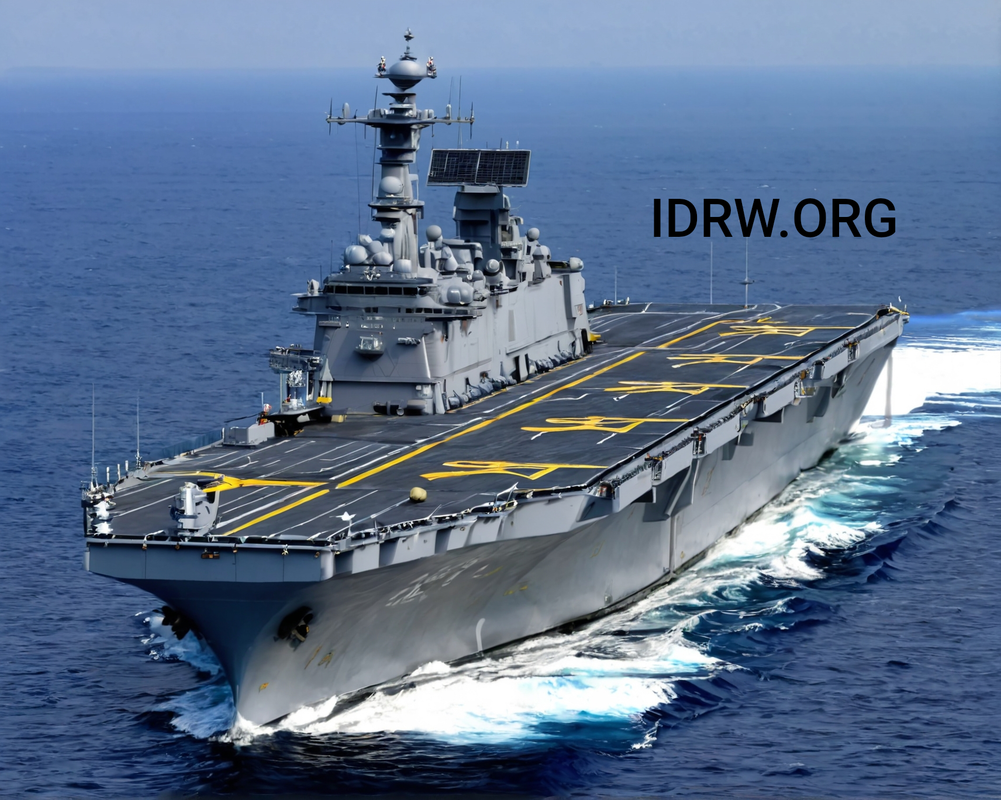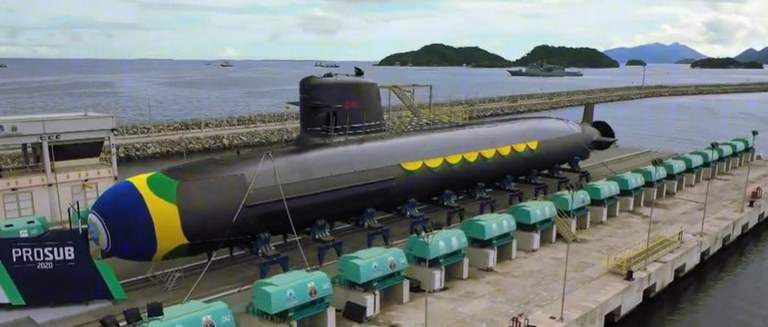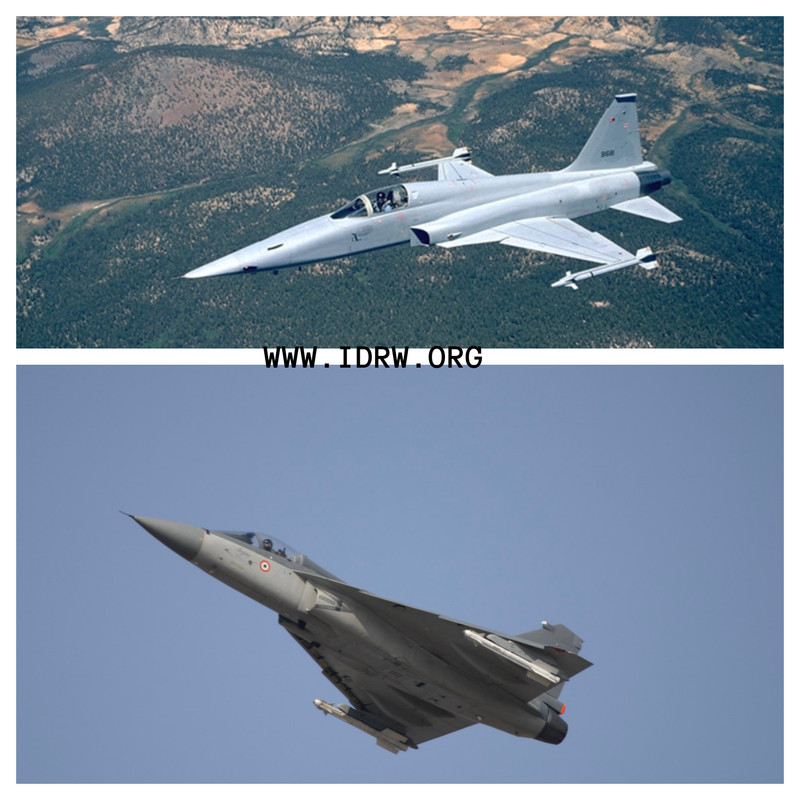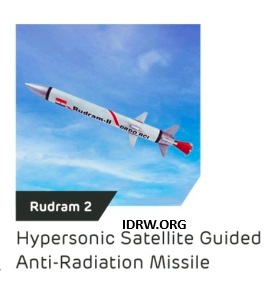SOURCE: IDRW.ORG TEAM

India has issued a Notice to Airmen (NOTAM) declaring a no-fly zone over a designated area of 1645 square kilometers from September 25, 2024, to September 30, 2024. The NOTAM indicates that a missile test is imminent.
While the specific details of the missile test remain undisclosed, it is widely speculated that India is preparing to conduct a trial of one of its ballistic missile systems. The extensive area covered by the NOTAM suggests that the missile may have a long range.
Continue readingSOURCE: RAUNAK KUNDE / NEWS BEAT / IDRW.ORG

Admiral Marcos Sampaio Olsen, the commander of the Brazilian Navy, during his recent visit to India, expressed a keen interest in collaborating with Indian experts to develop helicopter carriers for its fleet.
Brazil plans to locally build two helicopter carriers to replace its current flagship, the NAM Atlantico. This multi-purpose aircraft carrier was constructed by Vickers Shipbuilding and Engineering, a part of BAE Systems.
Continue readingSOURCE: RAUNAK KUNDE / NEWS BEAT / IDRW.ORG

Mazagon Dock Limited (MDL), a leading Indian shipyard, is making substantial advancements in the development of an indigenous 5MW Electric Propulsion Motor (EPM) for submarines. The company is aiming to complete the development and testing of this critical component by December 2027.
The 5MW EPM is intended for use in the Project-76 submarine program, under which the Indian Navy plans to develop an indigenous Air-Independent Propulsion (AIP)-equipped conventional submarine with a displacement of approximately 3000 tons.
Continue readingSOURCE: RAUNAK KUNDE / NEWS BEAT / IDRW.ORG

Admiral Marcos Sampaio Olsen, the commander of the Brazilian Navy, during his recent visit to India, expressed keen interest in the Fuel Cell-based Air Independent Propulsion (AIP) system developed by the Defence Research and Development Organisation’s (DRDO) Naval Materials Research Laboratory (NMRL).
The Admiral, who toured Mazagon Docks and other DRDO facilities, showcased a land-based prototype of the NMRL’s AIP system. This system has successfully undergone testing and is slated to be incorporated into the first Kalvari-class submarine in 2025.
Continue readingSOURCE: IDRW.ORG TEAM

Admiral Marcos Sampaio Olsen, the commander of the Brazilian Navy, has expressed interest in collaborating with India’s Mazagon Dock Limited (MDL) for a major refit of its Scorpène-class submarines.
Brazil operates the Riachuelo-class submarines, which are based on the French Scorpène design. The Indian Navy also has a fleet of six Kalvari-class submarines, which are essentially the same as the Riachuelo-class.
Continue readingSOURCE: IDRW.ORG TEAM

CAE Defense & Security USA has secured a significant contract to provide the Indian Navy with advanced training devices to support its fleet of Sikorsky MH-60R Seahawk helicopters. Valued at $57 million, the deal includes a tactical operational flight trainer (TOFT) and an avionics maintenance and weapons load trainer.
The training devices will be tailored to meet the specific requirements of the Indian Navy, featuring modifications such as an identification friend or foe interrogator and transponder, a traffic collision avoidance system, and the ability to simulate the use of anti-ship missiles and depth charges. These enhancements will ensure that Indian Navy personnel are fully equipped to operate and maintain the MH-60R helicopters effectively.
Continue readingSOURCE: RAUNAK KUNDE / NEWS BEAT / IDRW.ORG

Admiral Marcos Sampaio Olsen, the commander of the Brazilian Navy, has expressed interest in collaborating with India in the sector of nuclear-powered submarines, particularly focusing on technical and training aspects.
During a recent interview, Admiral Olsen highlighted Brazil’s advanced capabilities in nuclear technology. The country possesses significant uranium deposits, has mastered enrichment technology, and is nearing completion of small nuclear reactor development.
Continue readingSOURCE: RAUNAK KUNDE / NEWS BEAT / IDRW.ORG

In a setback for India’s Tejas Mk-1A fighter program, GE Aerospace has confirmed that the delivery of two F404-IN20 engines, originally scheduled for later this month, has been pushed back to November. This delay adds to the ongoing challenges faced by Hindustan Aeronautics Limited (HAL) in procuring the necessary engines for the production of the Tejas Mk-1A.
The Tejas Mk-1A, a more advanced variant of the Tejas light combat aircraft, made its maiden flight in March this year with Category B reserved engines. HAL had been relying on GE Aerospace to supply 16 engines for the current financial year. However, due to production constraints, the delivery schedule was revised, and GE Aerospace committed to providing six engines before the end of March 2025.
Continue readingSOURCE: RAUNAK KUNDE / NEWS BEAT / IDRW.ORG

India and the United States are inching closer to a joint venture to locally manufacture Stryker armoured infantry combat vehicles (ICVs). Following successful trials by the Indian Army, the US is pressing for the deal, despite India having domestic alternatives available at a significantly lower cost.
The US is keen to finalize the Stryker deal with India, emphasizing the vehicle’s capabilities and potential benefits for bilateral defence cooperation. However, the Indian Ministry of Defense (MoD) and the Indian Army are weighing their options carefully, considering both the Stryker and domestically developed alternatives.
Continue readingSOURCE: IDRW.ORG TEAM

In a recent interaction with Indian media, Lieutenant Brigadier Marcelo Kanitz Damasceno, Commander of the Brazilian Air Force, revealed that Brazil may consider India’s Tejas fighter jet as a potential replacement for its aging Northrop F-5 fleet, which is set to be retired post-2030. Damasceno acknowledged the need for additional fighter platforms alongside Brazil’s existing Gripen-E jets and expressed interest in the Tejas as a candidate for the role.
Currently, the Brazilian Air Force operates both the F-5 and the Gripen-E. However, as the F-5 approaches the end of its service life, Brazil will need to introduce a new platform to maintain its operational capabilities. Speaking about the search for a successor to the F-5, Damasceno noted, “We will need maybe two more kinds as the F-5 goes. So, while the Gripen remains, the Tejas is one of the options for our second or third fighter plane.”
Continue readingSOURCE: IDRW.ORG TEAM

The Defence Research & Development Organisation (DRDO) has achieved a significant milestone with the successful flight-testing of the RudraM-II air-to-surface missile from an Indian Air Force Su-30 MK-I aircraft off the coast of Odisha. This indigenously developed missile system is designed to neutralize various enemy assets, including surface-to-air missile (SAM) sites, radars, and air defense systems.
A number of advanced technologies developed by DRDO laboratories have been incorporated into the RudraM-II missile, showcasing India’s growing self-reliance in defense manufacturing. The missile’s capabilities and performance during the flight test have been lauded by defense experts and officials.
Continue readingSOURCE: RAUNAK KUNDE / NEWS BEAT / IDRW.ORG

Mazagon Dock Limited (MDL), a leading Indian shipyard, is working on validating locally developed packaging for Lithium-Ion Battery modules and testing them with a Battery Monitoring System (BMS) for submarines. This innovative technology is set to be integrated into three upcoming Kalvari-class submarines for the Indian Navy.
MDL aims to complete the development and testing of this new technology by December 2026. The three follow-on Kalvari-class submarines will be equipped with these upgraded Lithium-Ion Battery modules and BMS, offering significant improvements over the six Kalvari-class submarines already in service with the Indian Navy.
Continue readingSOURCE: RAUNAK KUNDE / NEWS BEAT / IDRW.ORG

As India and the United States inch closer to finalizing a deal for the local manufacturing of 99 F-414 engines, the country’s state-owned Hindustan Aeronautics Limited (HAL) is gearing up to establish a new production facility.
HAL has already identified suitable land for the facility and is developing plans to manufacture at least two engines per month at a peak production rate. The new F-414 production line is expected to commence operations in 2028, with an initial output of one engine per month. This rate will gradually increase to two engines per month, aligning with the planned production capacity of 24 Tejas MkII fighter jets annually by 2030-31.
Continue readingSOURCE: RAUNAK KUNDE / NEWS BEAT / IDRW.ORG

G. Ramamohana Rao, Director of the Vehicles Research and Development Establishment (VRDE), has confirmed that Bharat-Forge has obtained the Transfer of Technology (ToT) for the WhAP 8×8 wheeled armoured platform. This significant development paves the way for Bharat-Forge to produce its variants of the WhAP, tailored to meet specific customer requirements.
Following the footsteps of Tata and Mahindra, Bharat-Forge becomes the third company to secure ToT for the WhAP platform. Tata and Mahindra have already introduced their second-generation WhAP models, incorporating valuable feedback from the Indian Army and Central Reserve Police Force (CRPF).
Continue readingSOURCE: IDRW.ORG TEAM

Dr. Devanahalli Krishnamurthy Sunil (DKS) has officially assumed the role of Chairman and Managing Director (CMD) of Hindustan Aeronautics Limited (HAL). His appointment comes at a crucial time for the state-owned aerospace giant, as it faces challenges with the delivery schedule of the Tejas Mk1A fighter jet and the ongoing development of the Tejas MkII.
DKS will be tasked with addressing the delays in the Tejas Mk1A delivery schedule and securing a deal for 97 additional aircraft with the Indian Air Force (IAF). Additionally, he will oversee the critical phase of the Tejas MkII program, which is set to commence assembly next month.
Continue reading